IAN HUGO illustrates Anaïs Nin
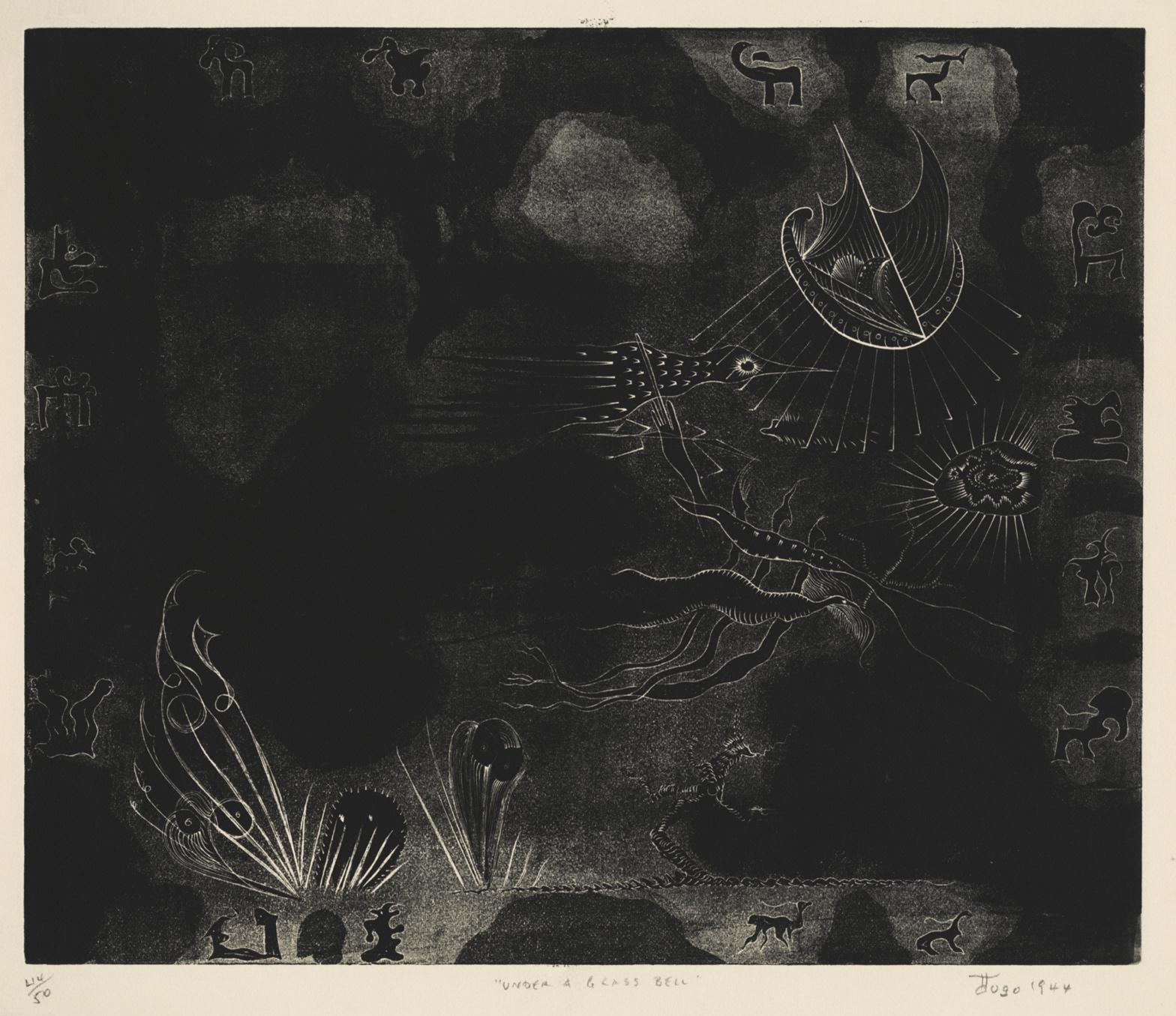
Surrealist engravings printed at Atelier 17 for the work of Anaïs Nin
The Annex Galleries 2025
In 1923 writer Anaïs Nin met and married an American banker named Hugh Parker Guiler in Havana, Cuba, marking the beginning of an unconventional lifelong partnership. The erotic novelist and her husband lived in Paris until 1939, when they fled to New York to escape the German invasion. It was here that Guiler’s personal artistic adventure took root. Using the pseudonym “Ian Hugo” to shield his financial career from his unorthodox private life, he began teaching himself how to paint.
Hugo learned of Stanley William Hayter’s experimental printmaking workshop, Atelier 17, in 1940 Like Hugo and Nin, Hayter and the workshop had temporarily relocated to New York from Paris due to the war Atelier 17 attracted artists from around the world including Louise Bourgeois, Joan Miro, Picasso, and hundreds more Hugo spent his spare time in the collaborative space, learning intaglio and relief printmaking while continuing to work in finance. When Nin couldn’t find a publisher willing to back her controversial writing, Hugo and a handful of close friends funded the opening of Gemor Press Nin was its director from 1942 to 1947 and Hugo would become the primary illustrator of her work
Nin’s first self-published novel, the American edition of Winter of Artifice, incidentally included Hugo’s first published artwork. These intaglios (the titles and editions of which are unknown) were used for both the cover and the interior vignettes The book was published in an edition of 500 and the reception for its publication was held at the Gotham Book Mart. It received critical acclaim from New York University’s director of graphic arts, Otto Furhman, and the editor of New Directions Press, James Laughlin. Thus began a collaboration between Nin and Hugo that would extend beyond the life of Gemor Press.
Hugo’s work for Anaïs Nin exemplifies Surrealism’s importance to both the visual and literary art world, with his biomorphic imagery reflecting the writer’s cerebral storytelling in a way that objective artwork would not. Hugo’s work for Nin was often reproduced for compilations, biographies, and other works pertaining to the writer well into the 1980s.
As a self-taught artist who treasured his privacy, Ian Hugo never pursued a professional art career. He treated his creative output as entirely experimental and eschewed formal editioning of his prints. As such, some of his works have countless proofs showing the changes he made to the plate but, due to the lack of editioning, there is often a non-linear evolution to each image. This spontaneousness makes Hugo’s work an excellent representation of early experimental printmaking.
In this catalogue, we’ve compiled some of the original prints by Hugo used in Nin’s novels and diaries of the 1940s. These intaglios and color woodengravings come directly from the artist’s estate and were originally printed at Atelier 17, though some impressions are from the 1978 edition printed by MadeleineClaude Jobrack under the direction of Hugo We have also included some ephemera at the end of the list to shed light on Hugo and Nin’s collaborative process.
The artworks are arranged chronologically according to their original creation
Partial list of works by Anaïs Nin illustrated by Ian Hugo, with the corresponding illustrations noted:
The Winter of Artifice (1942) – “Encircled,” “Mother of All”
This Hunger (1945, 1946) - “African Dream,” “Twilight Meeting” Ladders to Fire (1946) - “Ladders to Fire” House of Incest (1947 U.S. edition; cover embossed with 1944’s “Sea-Horse”)
The Four Chambered Heart (1950) – “Forest Woman” Cities of the Interior (1959) - “Mother of All,” “Floating Women” (cover)
The Winter of Artifice: Three Novelettes (1961 edition) - “Forest Women,” “Encircled”
The Diary of Anaïs Nin, Vols. Three and Four (1969, 1971) - “Under a Glass Bell” Anais: An International Journal, Vol. 4 (1986) - “Celebration”
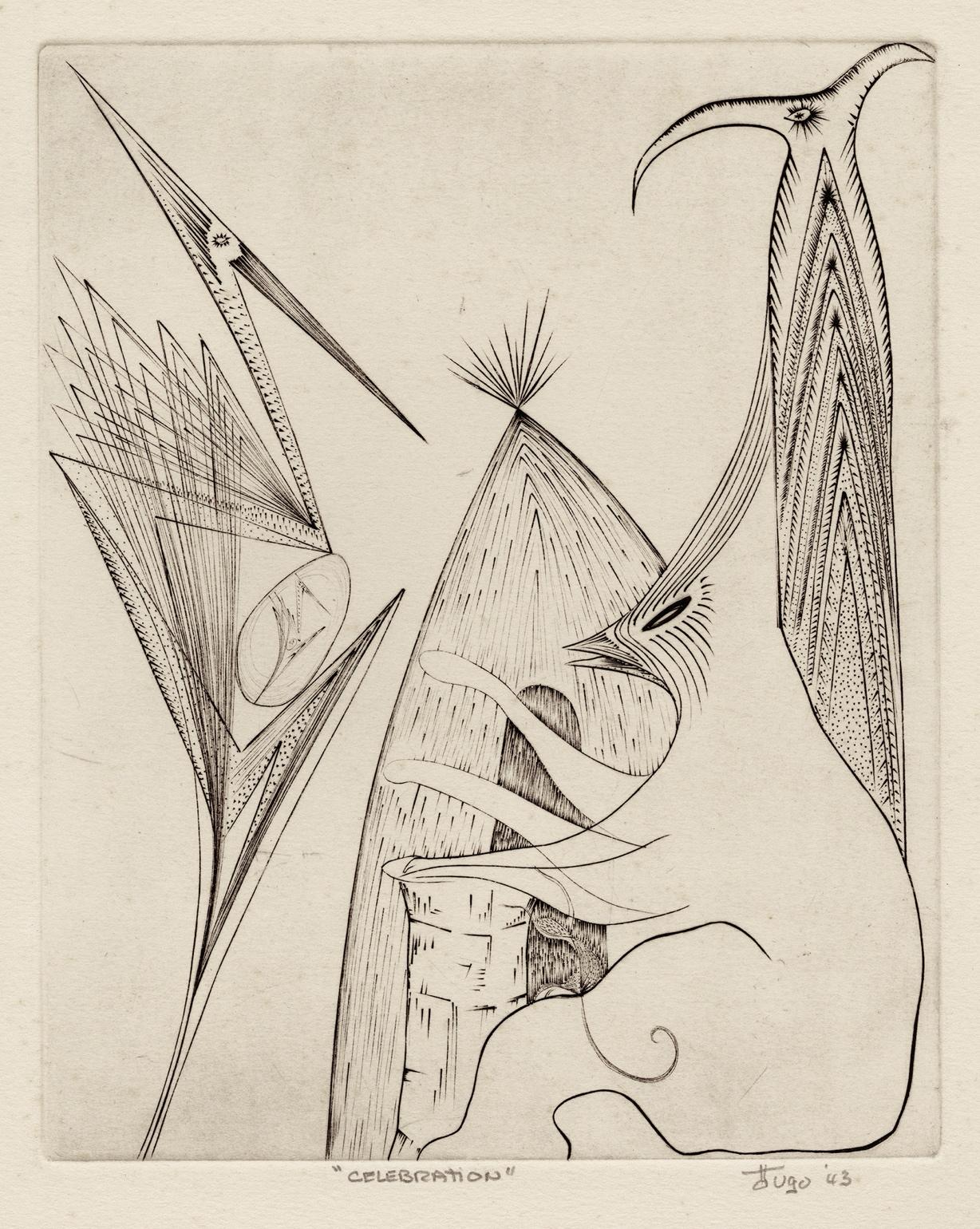
“Celebration” - Anais: An International Journal, Vol. 4 (1986)
Engraving, first printed in 1943 by the artist at Atelier 17, edition size not stated (proofs only); later printed by Madeleine-Claude Jobrack Editions, including this impression, under the direction of the artist (1978), and on the cover of Anais: An International Journal, Vol.4 (1986, Anaïs Nin Foundation, Los Angeles, California); this impression pencil signed, titled, and dated “1943” to signify the date of the plate’s creation. Annex Galleries inventory number 21060.

Under a Glass Bell” - Cover for Under a Glass Bell (1944); The Diary of Anaïs Nin Vols. Three and Four (1969, 1971)
Engraving, 1944; printed by the artist at Atelier 17, New York; published as the cover for “Under a Glass Bell,” (Gemor Press, 1944 and 1945); later uses of this image include covers for The Diary of Anaïs Nin, Vols. 3 and 4 (1969, 1971).
This impression pencil signed, dated, and titled. While Hugo has penciled an editioning of 44/50 in the lower left, the total impressions from 1944 remain unverified as he mentions in his notes that he only printed proofs.
This image was created in anticipation of the publication of Anaïs Nin’s seminal book Under a Glass Bell, and, would ultimately be used for the covers of all the editions published at Gemor. The second edition also featured nine interior engravings by Hugo. Inv. no. 21133.
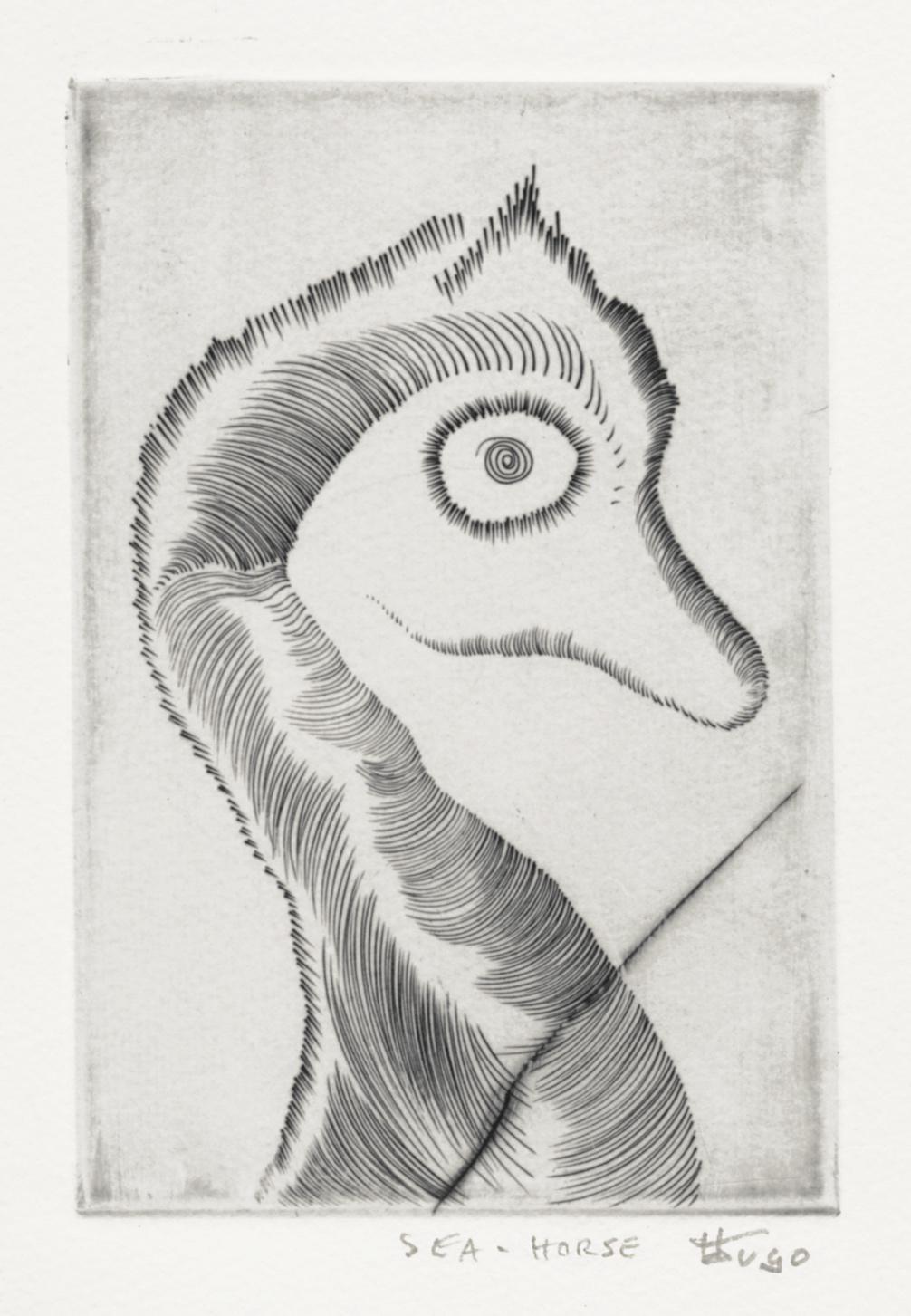
“Sea-Horse” – Cover (decorative stamp) for the U.S. edition of House of Incest (1947)
Engraving; first printed by the artist in an unknown edition in 1944 (possibly only proofs); seahorse without platemark used as the color-stamped embossment on the cover of the U.S. edition of House of Incest (1947, Gemor Press, NY; originally published 1936, Paris); this impression was printed in 1978 by Madeleine-Claude Jobrack Editions under the direction of the artist (not a part of the Ten Engravings portfolio); pencil signed and titled. Inv. no. 19330.

Title page for Under a Glass Bell (1945)
Engraving; first printed by the artist in or before 1945 to be used as the title page for Gemor Press’s second edition of Under a Glass Bell (1945); early edition size not stated (presumed small); this impression was printed in 1978 by Madeleine-Claude Jobrack Editions under the direction of the artist (not a part of the Ten Engravings portfolio); pencil signed; pencil dated “1945” to signify the date of the plate’s creation.
Typeset text added inside of the image for the 1945 printing read: “Anais Nin / Under a Glass Bell / Line Engravings on Copper / by Ian Hugo.” Inv. no. 23658.

“African Dream” – from This Hunger… (1945, 1946) and Engraved Woodblock Color Prints portfolio (1945)
Color woodengraving, 1945; variant color proof, from an edition of 40 published in a loose-leaf portfolio titled Engraved Woodblock Color Prints (1945, Gemor Press); pencil signed by the artist. A black and white version as well as various color versions of this image were used for Gemor Press editions of Nin’s This Hunger…. Inv. no. 21484.
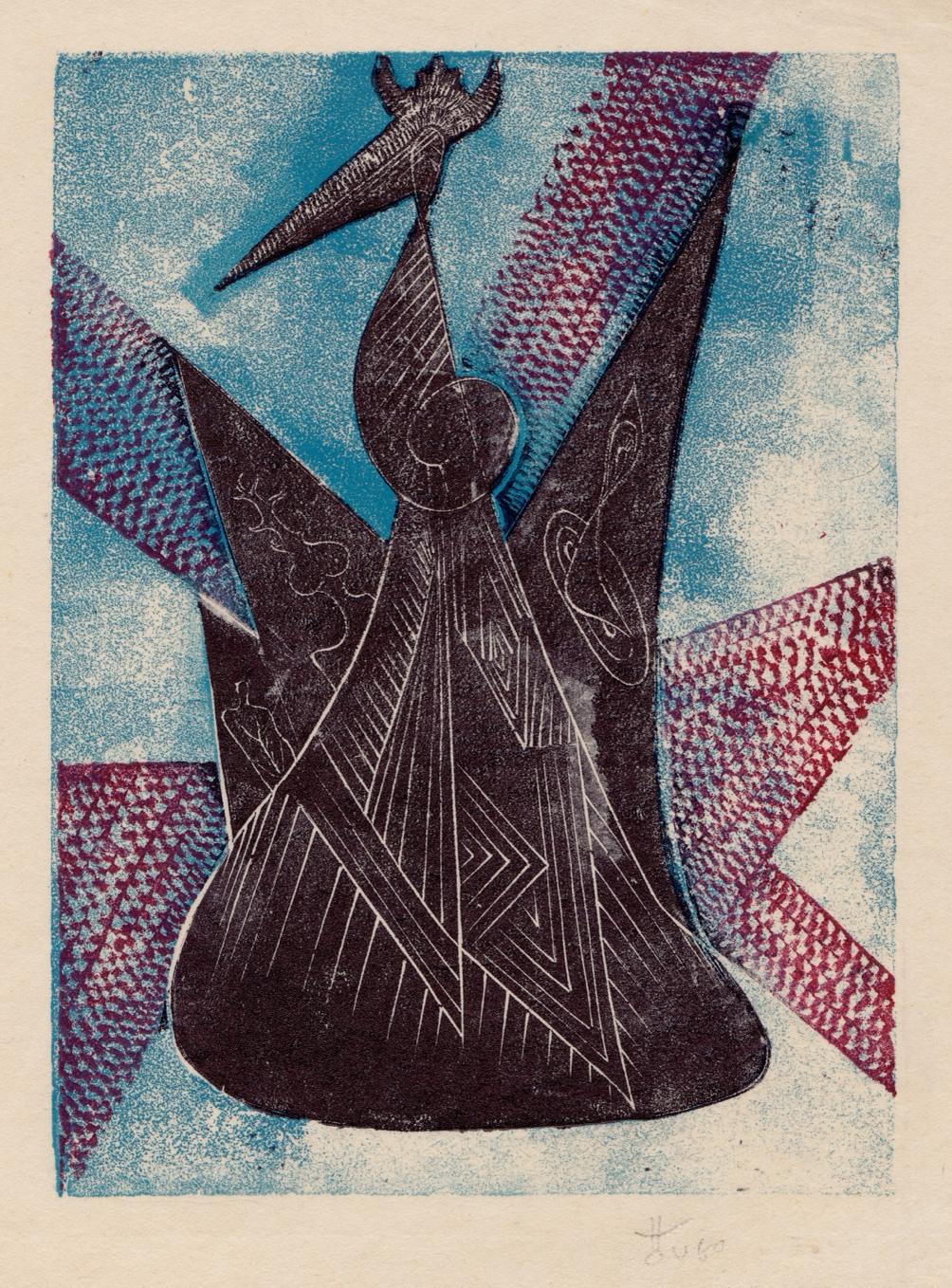
“Twilight Meeting” – from This Hunger… (1945, 1946) and Engraved Woodblock Color Prints portfolio (1945)
Color woodengraving, 1945; variant color proof, from an edition of 40 published in a loose-leaf portfolio titled Engraved Woodblock Color Prints (1945, Gemor Press); pencil signed by the artist. A black and white version of this image was used for various editions of Nin’s This Hunger…. Inv. no. 21485.

“Forest Woman” – Winter of Artifice: Three Novelettes (1961); Ten Engravings portfolio (1978); The Four-Chambered Heart (1964)
Engraving, first printed by the artist in an unknown edition in 1945 (possibly only proofs); later published in Winter of Artifice: Three Novelettes (1961, Swallow Press, Denver, Colorado); The Four-Chambered Heart (1964, Swallow Press); and in the Ten Engravings portfolio (1978), including this impression, published by Associated American Artists; printed by Madeleine-Claude Jobrack Editions under the direction of the artist; pencil signed, titled, editioned 26/50, and dated “1945” to signify the date of the plate’s creation.
Hugo also used this work to illustrate his article “New Eyes on the Art of Engraving,” issue No. 7, Outcast Chapbook Series, p. 8 (1946, Alicat Book Shop, Yonkers, NY). A woodengraving version of this work, in reverse, was also done by Hugo in 1945 and used for both the interior of This Hunger… and, in color, for the Engraved Woodblock Color Prints portfolio (1945, Gemor Press). Inv. no. 16395.

“Encircled” – Winter of Artifice: Three Novelettes (1961); Ten Engravings portfolio (1978)
Engraving; 1945; pencil signed, titled, dated, and editioned as 22/XXX (early edition size not verified); later published in Winter of Artifice: Three Novelettes (1961, Swallow Press, Denver, Colorado); and in the Ten Engravings portfolio, published in 1978 by Associated American Artists and printed by Madeleine-Claude Jobrack Editions under the direction of the artist. Inv. no. 19445.

“Ladders
to Fire” – published in Ladders to Fire (1946)
Engraving with softground etching, 1946; pencil signed, titled, and dated; edition size not stated (possibly only proofs); printed by the artist at Atelier 17 in anticipation of the publication of the book of the same name in 1946 (E.P. Dutton & Co., Inc., New York, NY, 1946); later impressions printed by MadeleineClaude Jobrack Editions under the direction of the artist (not as a part of the Ten Engravings portfolio). Inv. no. 23639.
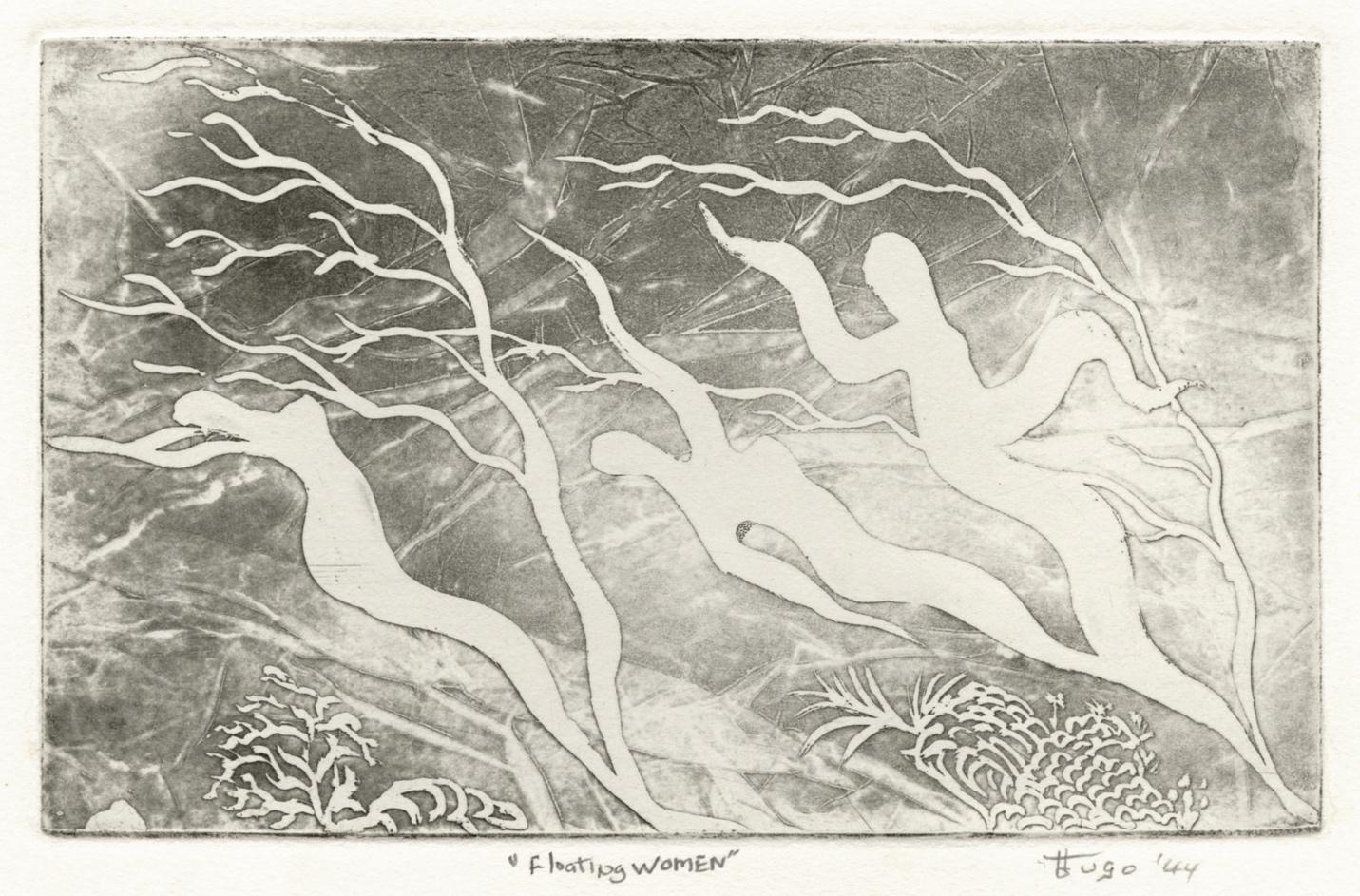
“Floating Women” – Cities of the Interior (cover, 1959); The Diary of Anaïs Nin, Vol. IV (1974)
Engraving, first printed in 1946 in an unknown edition (proofs only); later published as a cover for Cities of the Interior (1959, Phoenix Book Shop, Los Angeles, California) and in the Ten Engravings portfolio, including this proof impression, published by Associated American Artists, printed by Madeleine-Claude Jobrack Editions under the direction of the artist; pencil signed, titled, and dated “1944” to signify the date of the plate’s creation. Inv. no. 23637.
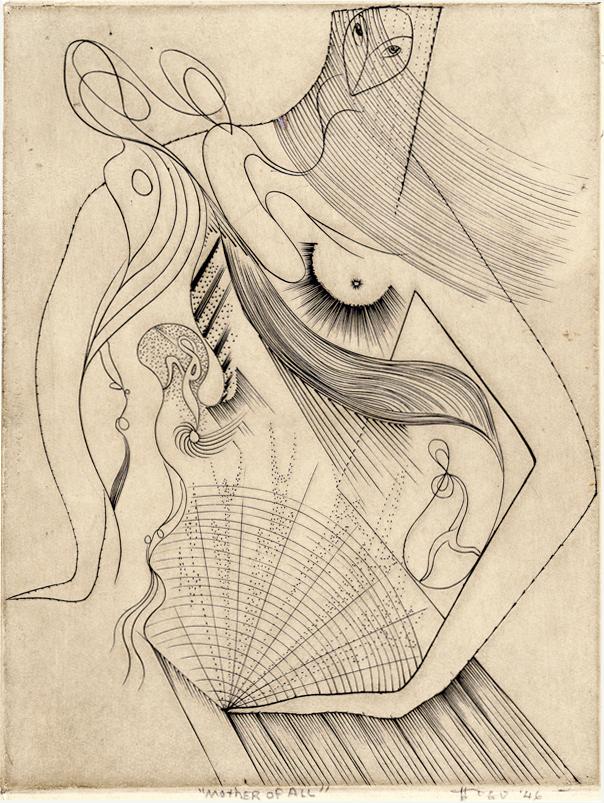
“Mother of All” – Cities of the Interior (1959) and Ten Engravings (1978)
Engraving, 1946; pencil signed, titled, and dated; edition size not state (only proofs in 1946); printed at Atelier 17, New York; later published as the cover to Cities of the Interior (1959, Swallow Press, Denver, Colorado); and in Ten Engravings, published by Associated American Artists, printed in 1978 by Madeleine-Claude Jobrack Editions under the direction of the artist. Inv. no. 19364.
EPHEMERA
Collaborative preparatory work and other ephemera pertaining to Nin’s writings and performances.
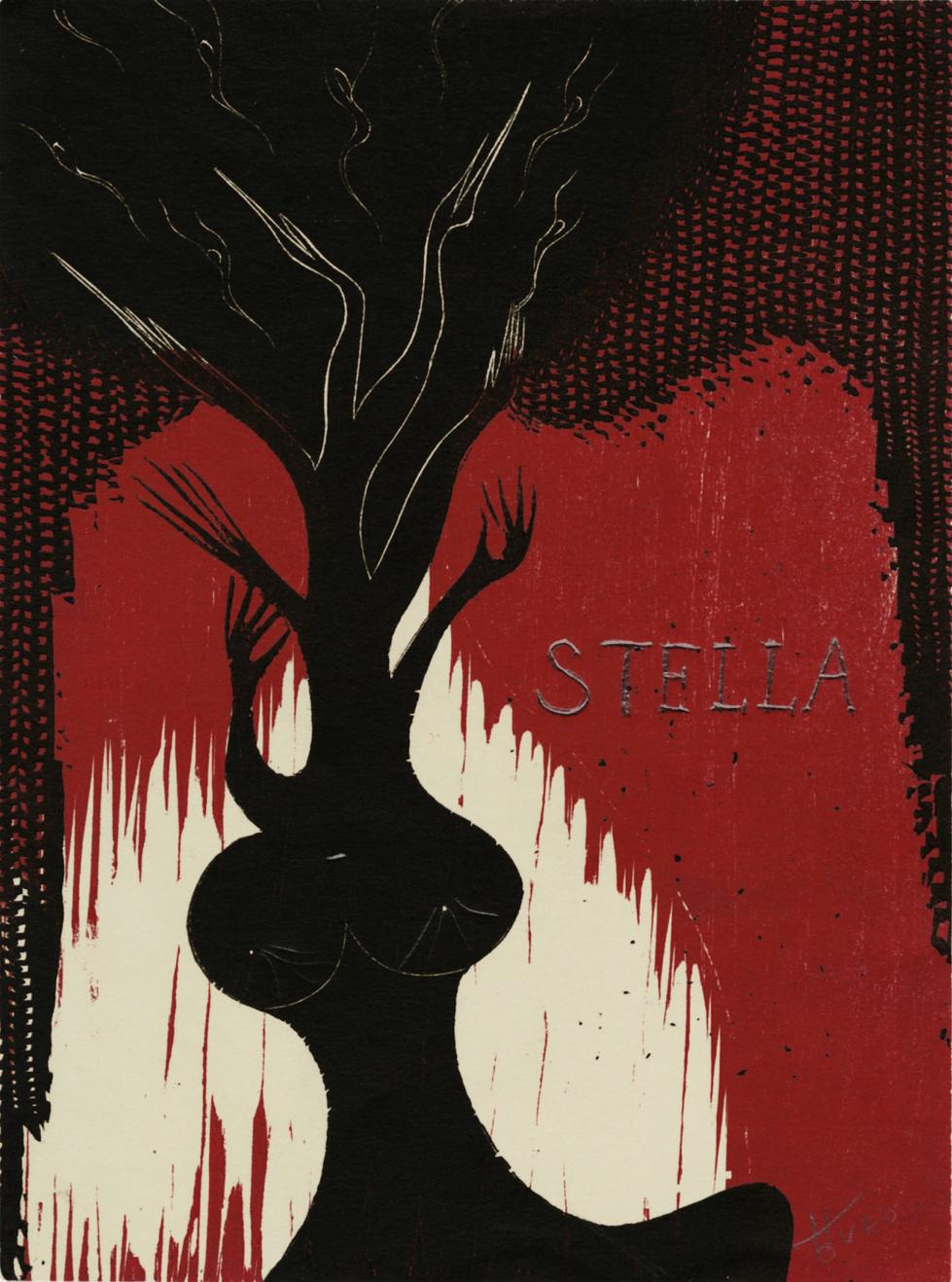
“Stella” (a.k.a “African Dream”) – Stella (1945; unpublished)
Color woodcut and woodengraving, 1945; preparatory layout for the cover of the novella titled Stella, which was never realized as an individual publication. The story was eventually published in various compilations, including the 1946 Dutton edition of Ladders to Fire and the 1961 Swallow Press edition of Winter of Artifice – Three Novellas. It was later included in The Portable Anaïs Nin (2007, Sky Blue Press digital publishing house, www.skybluepress.com).
This image was used in This Hunger… (1945, 1946, Gemor Press) and was included in the Engraved Woodblock Color Prints portfolio (1945, Gemor Press) in various color combinations

“The All Seeing Eye” (preparatory proof) – publication not known; annotated and signed (initialed) by Anaïs Nin
A lithographically reproduced Hugo engraving, ca. 1942-‘47 Printed for use in the layout process of a book, it is unknown at this time which book it was ultimately used for Annotations in pencil and ink indicate the direction of the layout (“top,” “bottom,” “outside,” “bind/inside”). A note from Anaïs Nin is written in the lower left reading, “I cannot trim this as I do not have measurements of book – Trim it and place it as well as you can in size of book page. A.N.”
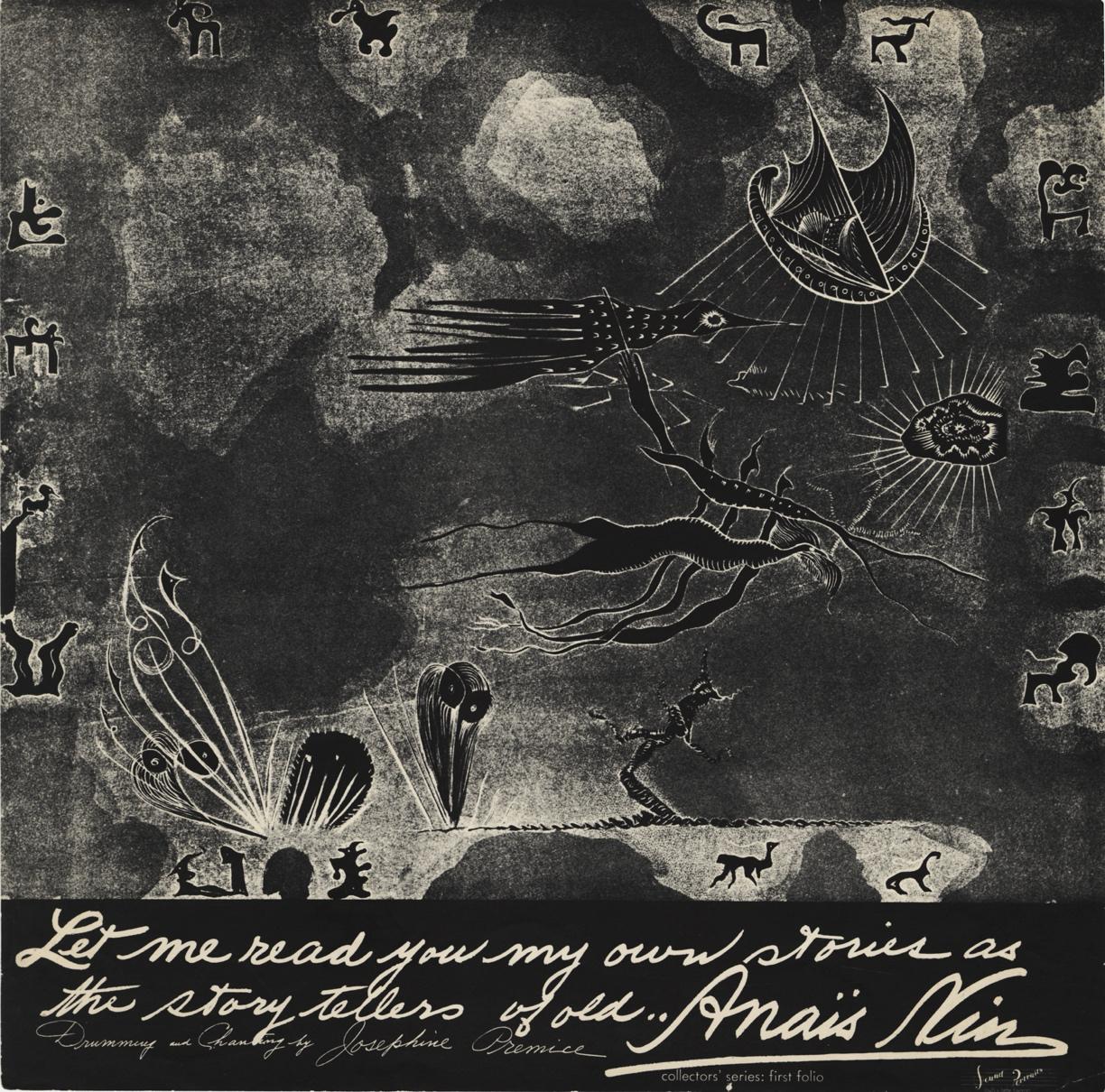
“Let me read you my own stories as the story tellers of old… Anaïs Nin” – album cover, 1949, Louis & Bebe Barron Sound Portraits Collector’s Series First Folio
A lithographically reproduced image of Ian Hugo’s “Under a Glass Bell” from 1944, printed in 1949 for the cover of the Louis and Bebe Barron’s two-album folio. The album featured Anaïs Nin reading her work against the drumming and chanting of actress and singer Josephine Premice
In 1949 the pioneering electronic recording artists Louis and Bebe Barron, under their Sound Portraits label, produced the four-part, two-album, 78 RPM folio that included the writings from Nin’s Under a Glass Bell: "House of Incest," (album 1, parts 1 and 2), "Child Born Out of the Fog" (album 2, part 1), and "Rag Time (album 2, part 2). The recordings took place in 1948 and were formally released the following year. The Barrons and Hugo continued to collaborate, creating the soundtracks for his films “Bells of Atlantis” and “Jazz of Lights.”

